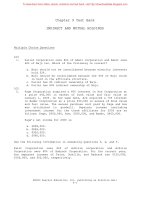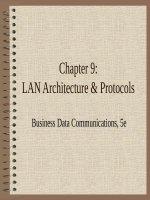Business data communications 5e by stallings chapter 09
Bạn đang xem bản rút gọn của tài liệu. Xem và tải ngay bản đầy đủ của tài liệu tại đây (135.6 KB, 29 trang )
Chapter 9:
LAN Architecture & Protocols
Business Data Communications, 5e
Personal Computer LANs
•
•
•
•
Client/server communication
Shared resources
Peer-to-peer communication
Low cost is high priority
Backend &
Storage Area Networks
•
•
•
•
•
•
“Computer room networks”
High data rate
High-speed interface
Distributed access
Limited distance
Limited number of devices
High-Speed Office Networks
• Increased processing and transfer requirements in
many graphics-intensive applications now require
significantly higher transfer rates
• Decreased cost of storage space leads to program
and file bloat, increased need for transfer capacity
• Typical office LAN runs at 1-20mbps, high-speed
alternatives run at 100+
Backbone Local Networks
•
•
•
•
Used instead of single-LAN strategy
Better reliability
Higher capacity
Lower cost
Factory Networks
•
•
•
•
•
High capacity
Ability to handle a variety of data traffic
Large geographic extent
High reliability
Ability to specify and control transmission
delays
Tiered LANs
• Cost of attachment to a LAN tends to
increase with data rate
• Alternative to connecting all devices is to
have multiple tiers
• Multiple advantages
– Higher reliability
– Greater capacity (less saturation)
– Better distribution of costs based on need
Tiered LAN Strategies
• Bottom-up strategy: individual
departments create LANs independently,
eventually a backbone brings them
together
• Top-down strategy: management develops
an organization-wide networking plan
Tiered LAN Diagram
Twisted Pair Wires
• Consists of two insulated copper wires
arranged in a regular spiral pattern to
minimize the electromagnetic interference
between adjacent pairs
• Often used at customer facilities and also
over distances to carry voice as well as
data communications
• Low frequency transmission medium
Types of Twisted Pair
• STP (shielded twisted pair)
– the pair is wrapped with metallic foil or braid
to insulate the pair from electromagnetic
interference
• UTP (unshielded twisted pair)
– each wire is insulated with plastic wrap, but
the pair is encased in an outer covering
Ratings of Twisted Pair
• Category 3 UTP
– data rates of up to 16mbps are achievable
• Category 5 UTP
– data rates of up to 100mbps are achievable
– more tightly twisted than Category 3 cables
– more expensive, but better performance
• STP
– More expensive, harder to work with
Twisted Pair Advantages
• Inexpensive and readily available
• Flexible and light weight
• Easy to work with and install
Twisted Pair Disadvantages
• Susceptibility to interference and noise
• Attenuation problem
– For analog, repeaters needed every 5-6km
– For digital, repeaters needed every 2-3km
• Relatively low bandwidth (3000Hz)
Coaxial Cable (or Coax)
• Used for cable television, LANs, telephony
• Has an inner conductor surrounded by a
braided mesh
• Both conductors share a common center
axial, hence the term “co-axial”
• Traditionally used for LANs, but growth of
twisted pair for local nets and optical fiber
for larger nets has reduced coax use
Fiber Optic Cable
• Thin (2 to 125 µm), flexible medium capable of
conducting an optical ray
• Advantages
–
–
–
–
Greater capacity
Smaller size/lighter weight
Lower attenuation
Electromagnetic isolation
• Operate in the range of about 1014 to 1015 Hz;
(portions of the infrared and visible spectrums)
Fiber Optic Layers
• consists of three concentric sections
plastic jacket
glass or plastic fiber core
cladding
Fiber Optic Types
• multimode step-index fiber
– the reflective walls of the fiber move the light pulses
to the receiver
• multimode graded-index fiber
– acts to refract the light toward the center of the fiber
by variations in the density
• single mode fiber
– the light is guided down the center of an extremely
narrow core
Fiber Optic Signals
fiber optic multimode
step-index
fiber optic multimode
graded-index
fiber optic single mode
Structured Cabling System
• Standards for cabling within a building
(EIA/TIA-568 and ISO 11801)
• Includes cabling for all applications, including
LANs, voice, video, etc
• Vendor and equipment independent
• Designed to encompass entire building, so that
equipment can be easily relocated
• Provides guidance for pre-installation in new
buildings and renovations
Structured Cabling Elements
LAN Protocol Architecture
• Layering of protocols that organize the
structure of a LAN
• Physical: Medium Access Control (MAC)
• Logical: Logical Link Control (LLC)
Advantages of standards
• Assure sufficient volume to keep costs
down
• Enable equipment from various sources to
interconnect
IEEE 802 Reference Model
• IEEE 802 committee developed, revises,
and extends standards
• Use a three-layer protocol hierarchy:
physical, medium access control (MAC),
and logical link control (LLC)
IEEE 802 Protocol Models
Compared to OSI Model









